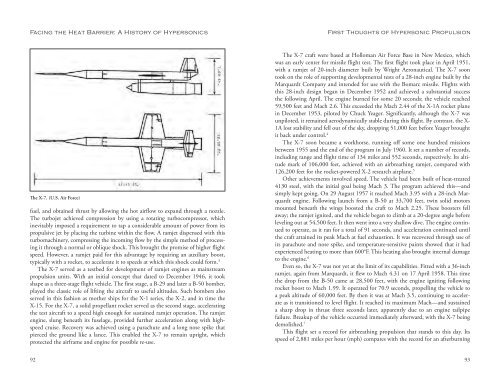Facing the Heat Barrier - NASA's History Office
Facing the Heat Barrier - NASA's History Office
Facing the Heat Barrier - NASA's History Office
Create successful ePaper yourself
Turn your PDF publications into a flip-book with our unique Google optimized e-Paper software.
<strong>Facing</strong> <strong>the</strong> <strong>Heat</strong> <strong>Barrier</strong>: A <strong>History</strong> of Hypersonics<br />
The X-7. (U.S. Air Force)<br />
fuel, and obtained thrust by allowing <strong>the</strong> hot airflow to expand through a nozzle.<br />
The turbojet achieved compression by using a rotating turbocompressor, which<br />
inevitably imposed a requirement to tap a considerable amount of power from its<br />
propulsive jet by placing <strong>the</strong> turbine within <strong>the</strong> flow. A ramjet dispensed with this<br />
turbomachinery, compressing <strong>the</strong> incoming flow by <strong>the</strong> simple method of processing<br />
it through a normal or oblique shock. This brought <strong>the</strong> promise of higher flight<br />
speed. However, a ramjet paid for this advantage by requiring an auxiliary boost,<br />
typically with a rocket, to accelerate it to speeds at which this shock could form. 3<br />
The X-7 served as a testbed for development of ramjet engines as mainstream<br />
propulsion units. With an initial concept that dated to December 1946, it took<br />
shape as a three-stage flight vehicle. The first stage, a B-29 and later a B-50 bomber,<br />
played <strong>the</strong> classic role of lifting <strong>the</strong> aircraft to useful altitudes. Such bombers also<br />
served in this fashion as mo<strong>the</strong>r ships for <strong>the</strong> X-1 series, <strong>the</strong> X-2, and in time <strong>the</strong><br />
X-15. For <strong>the</strong> X-7, a solid propellant rocket served as <strong>the</strong> second stage, accelerating<br />
<strong>the</strong> test aircraft to a speed high enough for sustained ramjet operation. The ramjet<br />
engine, slung beneath its fuselage, provided fur<strong>the</strong>r acceleration along with highspeed<br />
cruise. Recovery was achieved using a parachute and a long nose spike that<br />
pierced <strong>the</strong> ground like a lance. This enabled <strong>the</strong> X-7 to remain upright, which<br />
protected <strong>the</strong> airframe and engine for possible re-use.<br />
92<br />
First Thoughts of Hypersonic Propulsion<br />
The X-7 craft were based at Holloman Air Force Base in New Mexico, which<br />
was an early center for missile flight test. The first flight took place in April 1951,<br />
with a ramjet of 20-inch diameter built by Wright Aeronautical. The X-7 soon<br />
took on <strong>the</strong> role of supporting developmental tests of a 28-inch engine built by <strong>the</strong><br />
Marquardt Company and intended for use with <strong>the</strong> Bomarc missile. Flights with<br />
this 28-inch design began in December 1952 and achieved a substantial success<br />
<strong>the</strong> following April. The engine burned for some 20 seconds; <strong>the</strong> vehicle reached<br />
59,500 feet and Mach 2.6. This exceeded <strong>the</strong> Mach 2.44 of <strong>the</strong> X-1A rocket plane<br />
in December 1953, piloted by Chuck Yeager. Significantly, although <strong>the</strong> X-7 was<br />
unpiloted, it remained aerodynamically stable during this flight. By contrast, <strong>the</strong> X-<br />
1A lost stability and fell out of <strong>the</strong> sky, dropping 51,000 feet before Yeager brought<br />
it back under control. 4<br />
The X-7 soon became a workhorse, running off some one hundred missions<br />
between 1955 and <strong>the</strong> end of <strong>the</strong> program in July 1960. It set a number of records,<br />
including range and flight time of 134 miles and 552 seconds, respectively. Its altitude<br />
mark of 106,000 feet, achieved with an airbreathing ramjet, compared with<br />
126,200 feet for <strong>the</strong> rocket-powered X-2 research airplane. 5<br />
O<strong>the</strong>r achievements involved speed. The vehicle had been built of heat-treated<br />
4130 steel, with <strong>the</strong> initial goal being Mach 3. The program achieved this—and<br />
simply kept going. On 29 August 1957 it reached Mach 3.95 with a 28-inch Marquardt<br />
engine. Following launch from a B-50 at 33,700 feet, twin solid motors<br />
mounted beneath <strong>the</strong> wings boosted <strong>the</strong> craft to Mach 2.25. These boosters fell<br />
away; <strong>the</strong> ramjet ignited, and <strong>the</strong> vehicle began to climb at a 20-degree angle before<br />
leveling out at 54,500 feet. It <strong>the</strong>n went into a very shallow dive. The engine continued<br />
to operate, as it ran for a total of 91 seconds, and acceleration continued until<br />
<strong>the</strong> craft attained its peak Mach at fuel exhaustion. It was recovered through use of<br />
its parachute and nose spike, and temperature-sensitive paints showed that it had<br />
experienced heating to more than 600°F. This heating also brought internal damage<br />
to <strong>the</strong> engine. 6<br />
Even so, <strong>the</strong> X-7 was not yet at <strong>the</strong> limit of its capabilities. Fitted with a 36-inch<br />
ramjet, again from Marquardt, it flew to Mach 4.31 on 17 April 1958. This time<br />
<strong>the</strong> drop from <strong>the</strong> B-50 came at 28,500 feet, with <strong>the</strong> engine igniting following<br />
rocket boost to Mach 1.99. It operated for 70.9 seconds, propelling <strong>the</strong> vehicle to<br />
a peak altitude of 60,000 feet. By <strong>the</strong>n it was at Mach 3.5, continuing to accelerate<br />
as it transitioned to level flight. It reached its maximum Mach—and sustained<br />
a sharp drop in thrust three seconds later, apparently due to an engine tailpipe<br />
failure. Breakup of <strong>the</strong> vehicle occurred immediately afterward, with <strong>the</strong> X-7 being<br />
demolished. 7<br />
This flight set a record for airbreathing propulsion that stands to this day. Its<br />
speed of 2,881 miles per hour (mph) compares with <strong>the</strong> record for an afterburning<br />
93
















